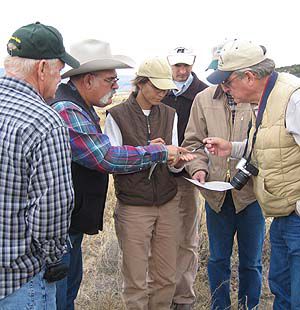| Conservationist Dana Truman points to the different types of seeds the state, local and federal development partnership will plant as part of a project to promote rangeland recovery in southeastern Utah. The southeast region encompasses Carbon, Emery, Grand. Garfield and San Juan counties. |
The partnership for conservation and development conducted a regional meeting and range tour in Carbon County on Nov. 10.
The group meets quarterly and last Thursday’s session was the first gathering scheduled in Carbon County.
The UPCD Partnership is a coalition of government agencies and private landowners formed two years ago as a part of the Utah Watershed Restoration Initiative.
The goal of the partnership is to restore and manage Utah wildlife habitat and to develop and improve overall land and ecosystem health throughout the state.
The concept of the partnership is simple. It is a way to share state and federal resources, manpower and expertise by having all of the government agencies coordinate efforts and work together.
The group represents state and federal natural resource agencies, universities, county and local governments, private landowners and conservation organizations.
The partnership’s organization and guiding principles are outlined in a joint resolution supported by all participants and Utah’s governor.
The joint resolution identifies a long-term need to address the risks to natural resources and develop a shared set of priorities for the restoration and management of state, federal, and private lands.
It is also a way to pool technical and financial resources and improve communication among the participants.
Federal signatories to the agreement include the United States Forest Service, bureau of land management, Farm Service Agency, natural resources conservation agency, national parks and the U.S. Fish and Wildlife Service.
State agencies include the Utah Division of Wildlife Resources, soil conservation commission, environmental quality department, institutional trust lands administration, natural resources department and Utah State University Extension Service.
In all, 15 different government agencies are involved in the partnership.
The group was formed as a series of teams. There is a statewide core team and five regional teams representing the diverse geographical regions of the state.
The purpose of the teams is to coordinate efforts and to provide a way to share conservation concerns and priorities, act as a forum to discuss possible solutions. and provide the means to foster an atmosphere of cooperation between agencies.
The southeast regional team represents the interests of Carbon, Emery, Grand, Garfield and San Juan counties.
The partnership has identified common resource issues that go beyond individual agency jurisdictions. The shared goal focuses on preserving Utah’s native wildlife and biological diversity; improving and managing water quality for municipal, wildlife and agricultural uses; maintaining sustainable agriculture through working farms and ranches; and providing outdoor recreation opportunities, access, delivery and quality.
Representatives from nearly all of the partner agencies were present at the local event .
Regional Utah Division of Wildlife personnel hosted the gathering. DWR habitat manager Chris Colt and habitat biologist David Cook took charge of the meeting. Cook works as the DWR liaison officer for the partnership and he was the principal speaker at the event. Carbon County lands -access coordinator Rex Sacco and USU Extension agent Ron Patterson were participants at the gathering.
The tour began in lower Gordon Creek south of the Wildcat railroad siding. There, Cook showed the group a range restoration project in progress. A caterpillar was dragging a large machine called a Lawson Aerator that ripped up dead sagebrush, punched holes in the ground and planted new seed all in one pass.
Cook explained the mechanics of the process, the need for the restoration, and the goals of the project. He talked about the cooperative effort and how various agencies had contributed to the project. He explained that the project goal was the restoration of critical mule deer habitat, improved livestock grazing, and overall health of the watershed.
The tour then proceeded to Porphyry Bench above Pinnacle Peak where a year-old range restoration project was viewed. There, new grass and sage sprouts are growing and the rangeland is recovering. Cook, Colt, and Patterson all spoke about the conservation efforts and what it has taken to restore the range to such a condition.
The event demonstrated what the UPCD team effort has accomplished in a short time.

